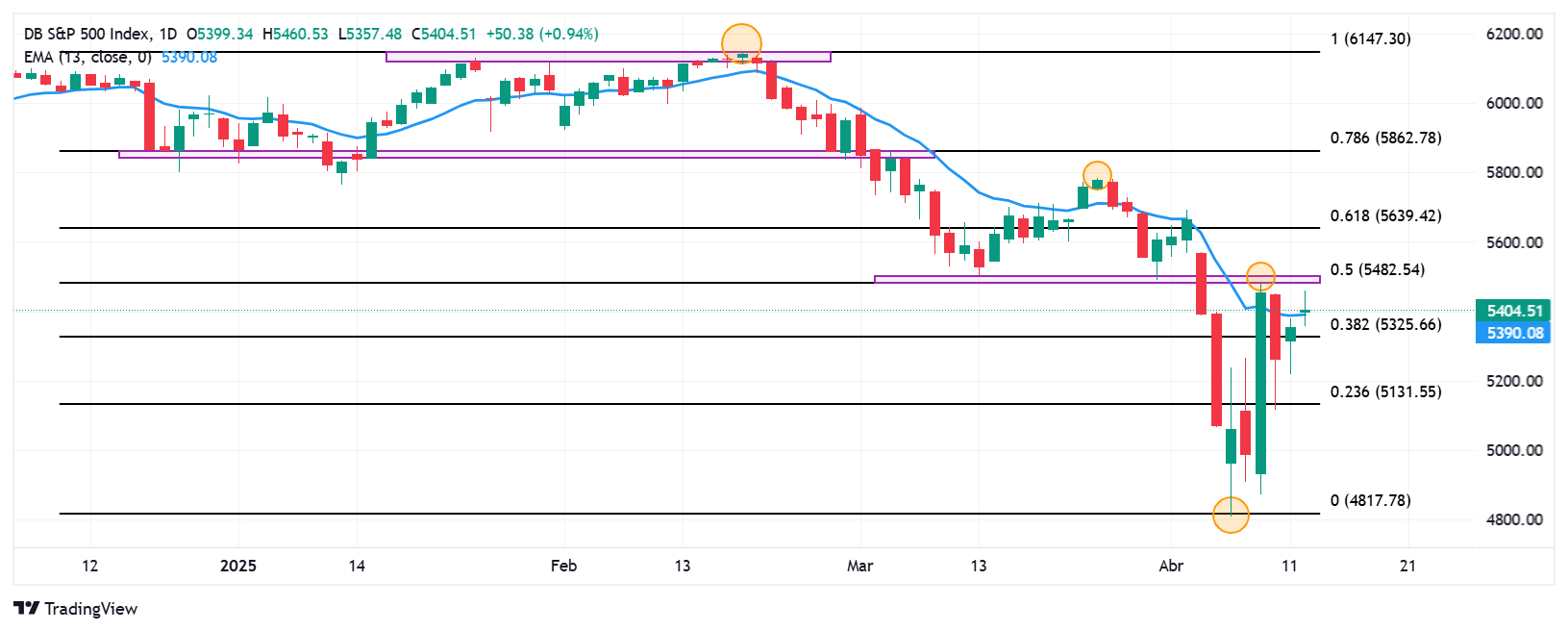- The S&P 500 stock index rises 0.94% in the day, currently quoting at 54.04.
- Christopher Waller, a member of the FOMC, said that tariff policy represents a significant shock for the United States economy.
- The US Treasury Secretary, Scott Besent, reiterated is looking for fair trade negotiations with its commercial partners.
- The look of investors will be placed on retail sales in the United States and Jerome Powell’s speech on Wednesday, April 16.
The S&P 500 established a minimum of the day in 5,357, attracting buyers who promoted the maximum index of April 9 in 5,460. At the moment, the S&P 500 operates over 5,404, winning 0.94% daily.
The S&P extends its earnings attentive to tariff negotiations between the US and China
The president of the United States, Donald Trump, announced in Truth Social, the tariff adjustment to electronic and semiconductor products from 145% to 20%, feeding the hopes of positive commercial negotiations.
In this sense, the Secretary of the Treasury, Scott Besent, declared that the US is looking for “fair” commercial negotiations with countries interested in tariff exemptions, highlighting that the US dollar remains a global reserve currency.
On the other hand, Christopher Waller, a member of the Federal Open Market Committee, acknowledged that the new tariff policy is one of the greatest shocks that affect the economy of the United States.
In this context, the S&P 500 concludes Monday with a gain of 0.94%, rising 50 points, reaching maximum of April 9 in 5,460, resuming the upward perspective in tune with the main share rates.
Levels to be considered in the S&P 500
The S&P 500 established a short -term support given by the minimum of April 7 in 4.810. Upwards, the closest resistance is observed in 5,784, maximum of March 25. The next key resistance is 6,145, a pivot point of February 19.
S&P 500 DAILY GRAPH

S&P 500 FAQS
The S&P 500 is a very often stock index that measures the yield of 500 public companies and is considered a wide measure of the US stock market. The influence of each company on the calculation of the index is weighted based on stock capitalization. This is calculated by multiplying the number of bought shares of the company for the price of the action. The S&P 500 index has achieved impressive yields: 1.00 $ invested in 1970 would have produced a yield of almost $ 192.00 in 2022. The average annual profitability since its creation in 1957 has been 11.9%.
Companies are selected by Committee, unlike other indices that are included based on established standards. Even so, they must fulfill certain eligibility criteria, the most important of which is stock market, which must be equal to or greater than 12.7 billion dollars. Other criteria are liquidity, domicile, stock capitalization, sector, financial viability, quotation time and representation of the sectors of the United States economy. The nine largest companies in the index represent 27.8% of the stock market capitalization.
There are several ways to operate with the S&P 500. Most of the Stred Betting retail runners and platforms allow operators to use contracts per difference (CFD) to make bets on the price direction. In addition, indexed funds, investment funds and quoted funds (ETF) that follow the price of the S&P 500 can be purchased. The most ETF liquid is the ETF of the London Stock Exchange. The most ETF liquid is the State Street Corporation Spy. The Chicago Mercantile Exchange (CME) offers futures contracts on the index and the Chicago Board of Options (CMOE) offers options, as well as ETF, ETF Inverse and ETF leverage.
There are many factors that promote S&P 500, but mainly it is the aggregate performance of the companies that compose it, revealed in their reports of quarterly and annual results. American and world macroeconomic data also contribute, since they influence investors’ confidence, which is positive drives profits. The level of interest rates, set by the Federal Reserve (FED), also influences the S&P 500, since it affects the cost of credit, which is largely depending on many companies. Therefore, inflation can be a determining factor, as well as other parameters that influence the decisions of the Federal Reserve.
Source: Fx Street
I am Joshua Winder, a senior-level journalist and editor at World Stock Market. I specialize in covering news related to the stock market and economic trends. With more than 8 years of experience in this field, I have become an expert in financial reporting.







